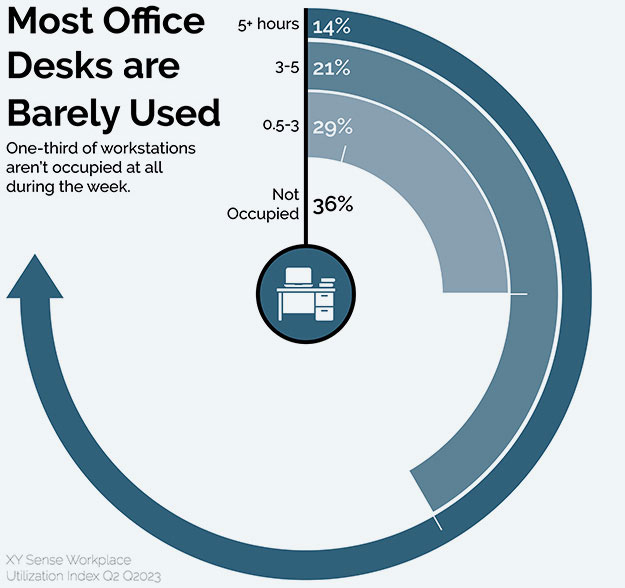 No matter the office or workstation size, the desk is the primary functional object in the workspace, and yet, more than one-third of desks in offices around the globe are unoccupied all week, according to the XY Sense report. The findings show that 36% of work points — workstations and desks — are never occupied.
No matter the office or workstation size, the desk is the primary functional object in the workspace, and yet, more than one-third of desks in offices around the globe are unoccupied all week, according to the XY Sense report. The findings show that 36% of work points — workstations and desks — are never occupied.
This desk vacancy may indicate over-supply or the wrong kit-of-parts at the wrong time… and so it may be time to plan for a significant transition in workplace design strategy. Along with organizational reassessment of the work being performed, a new approach to work enabling tools, such as office furnishings, to support activities required to complete tasks and goals on a daily basis, is on our horizon.
Imagine using an app to order and custom furnish your workplace on a daily basis. Most of us already subscribe to a multitude of product delivery services so why not one that allows you to order furniture kit of part, and installation, on demand.

Companies must reimagine what’s possible for their workspace. For those who have embraced remote work holistically, but still embrace and value company, real estate can provide a flexible solution. We proposed an approach of intentional applications, via furniture and real estate as a service, and use of space based on work activity on any given day or even throughout one day. A tailored efficient process model that employs a kit of parts, and on-demand FFE to facilitate productivity, training, and company culture needs, through multiple work modalities.
This dynamic nature of space use can support highly flexible remote workforces who are able to structure and schedule their activities. Asset management on or off site via contracted service providers, based on standardized quality, quantity and size of product offering to make process easy and seamless. Each activity dictates a kit of parts that is ordered on demand via an app. For example, you might say “Today, my team needs 20 sit-stand desks for focus activity, but tomorrow teams will break out in project groups and need team tables, white boards, and digital smart boards to facilitate their work.”



This method will be highly intentionally and planned while supporting agile teams, hybrid workflows, and maximizing the real estate footprint. It can also help facilitate a sublease model during times of scheduled surplus to support space sharing with another compatible tenants. Maximizing use of base building shared amenities, such as larger enclosed meeting rooms, cafes, and office “Staples” spaces, will help to optimize lease space for agile activities with on-demand furniture conversions.
We have grown accustomed to mobile ordering all kinds of essentials for our daily lives, from food to office supplies, this solution is an Uber-ization of tools needed to perform and optimize our daily work modalities.
